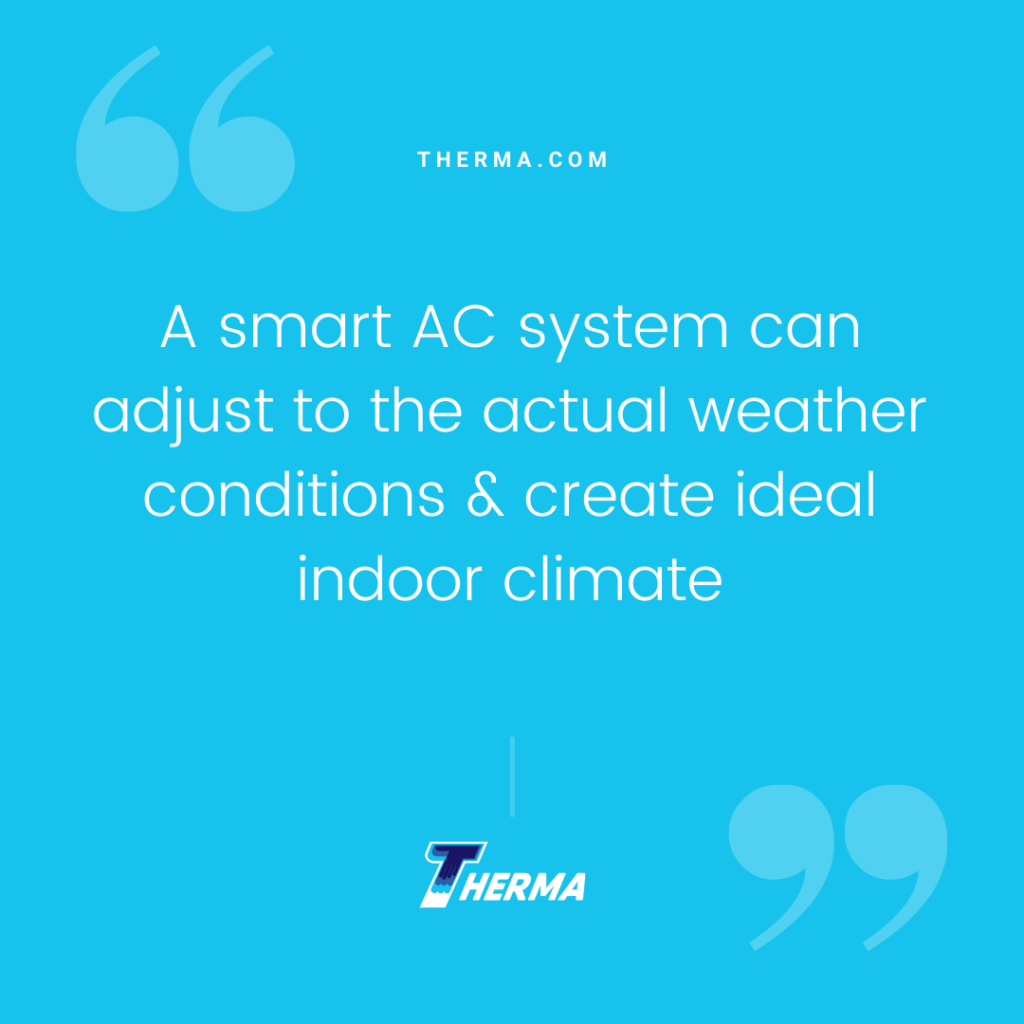by Ali Kriscenski
Smart AC systems are reshaping the air conditioning industry with internet-connected devices that provide convenience, comfort, safety and savings. The innovations in air conditioning keep pace with the rise of IoT and the connectivity of everyday devices from personal phones to cars to vending machines. Smart ACs are a response to the shifts in consumer demands towards responsive, intuitive systems to manage building climate control.
What Is Smart AC?
Internet connected devices have infiltrated most industries, and air conditioning is no exception. Smart AC systems are designed to connect to the internet and utilize all of the benefits that internet connectivity provides. Smart AC goes beyond just setting cooling parameters which programmable thermostats allow. Smart AC systems can integrate a variety of sensors which inform the system performance in direct relation to specific cooling requirements.
Smart AC systems can use thermal sensors to detect conditions in various spaces throughout a building or room. As connected devices, these components can send data to the smart AC system to adjust cooling to changing conditions. Connected devices can include thermal, humidity, light and occupancy sensors.
 Benefits of Smart AC
Benefits of Smart AC
The connectivity of smart ACs allow building managers to set and control air conditioning settings through a centralized programming system. This capability provides significant advantages over conventional air conditioning. Here’s a look at the benefits that make smart ACs a worthwhile investment.
1. Thermal Comfort
Air conditioning serves several purposes, including protecting building materials and providing healthy, safe environmental conditions for occupants. The industry standards for thermal comfort provide guidelines for temperature and humidity ranges that support health, wellness and productivity. Set by the American Society of Heating, Refrigerating and Air-Conditioning Engineers (ASHRAE), the standard for Thermal Environmental Conditions for Human Occupancy notes the ideal temperature range for thermal comfort between 67 °F and 82 °F.
The range is a guideline that can be further refined to meet requirements created by relative humidity, season, occupant attire, activity levels, program use and occupancy levels. As the variables change throughout the day, week, and year, the air conditioning system needs to be set accordingly to maintain thermal comfort levels. While conventional systems allow for settings to be scheduled around planned variations, smart AC systems use real-time feedback to inform automatic adjustments to the system settings.
2. Energy Efficiency and Savings
As responsive systems, smart ACs can create energy savings by reacting to temperature and humidity conditions that provide opportunity for decreased energy use. While programmed thermostats can be set for certain temperatures throughout the day, a smart AC system can help create ideal conditions based on actual requirements.
For example, during April in California, outdoor temperatures can range between 46 °F to 75 °F. This range, coupled with varying humidity, can create very different cooling requirements for interior spaces. Where conventional AC can be set for daily temperature schedules, a smart AC system can adjust to the actual weather conditions and create ideal indoor climate despite variations to seasonal averages. This capability leads to energy savings, as the energy used for cooling meets the demand rather than exceeding it.
3. System Diagnosis and Maintenance
For building managers, smart AC systems provide data, notifications, and reporting that can help improve system diagnosis and preventative maintenance (PM) planning. Smart AC systems track energy usage, and can provide more accurate system maintenance needs based on usage and demand. Preventative maintenance is of particular importance in commercial facilities where an HVAC disruption can halt production of goods or services.
What Smart AC Offers Facility Managers
The features that distinguish smart AC systems from conventional air conditioning are game changers for facility and building managers. Geolocation, occupancy level modes, data collection and building automation systems (BAS) integration are just a few of the facets of smart AC that can help building operations and efficiency.
 Seasonal Alignment
Seasonal Alignment
In certain climates, seasonal weather can be widely varied. In New England for example, spring days could bring showers, sunshine, or even snow, and temperatures could be anywhere between 35 °F and 70 °F within a few days. Smart ACs feature geolocation making them particularly helpful in adjusting to seasonal weather patterns and providing ideal climate control for building occupant comfort. Within set parameters, smart ACs can utilize data collected from building sensors to accommodate for unseasonable weather fluctuations. This automated, responsive capability helps keep occupants comfortable, keep environmental conditions within desired ranges and contributes to energy savings by reducing unnecessary energy use.
Building Occupancy Modes
Building occupancy has had extreme fluctuations over the past several years, with remote work leaving many buildings at low or even no occupancy. Occupancy levels play a role on HVAC demand, as lower occupancy reduces air flow from egress, as well as heat from lighting and equipment usage. Smart AC systems allow for customized settings that meet a building’s particular occupancy patterns, and create energy savings.
Building Automation Systems Integration
The demand for improved building efficiency is never-ending. Building owners and occupants seek intelligent, data-enabled automation and controls to serve their business operations needs. Smart AC systems can integrate with BAS, making it possible to control air conditioning in sync with lighting, security and other building systems.
Building Data Collection and Reporting
Smart AC systems provide building managers with data on energy usage, occupancy levels, temperature, and humidity variations over days, weeks, and seasons. This information conveys cooling demand, system efficiency, and energy costs. When analyzed by facility managers and HVAC professionals, this data can be useful in creating preventative maintenance programs. The communication between smart AC components provides more accurate diagnostics where devices may need repair or replacement. Overall, smart AC data collection, alerts, and reporting help building managers stay ahead of maintenance and repairs, ultimately leading to extended system lifespans.
The Future of AC is Automated
As consumers and businesses become more dependent on internet connected devices, smart ACs make more and more sense. They are tools to improve occupant comfort, convenience, and energy savings. As facility managers utilize BAS more, and navigate towards smart and automated devices for building monitoring, smart ACs are a logical step. Contact our HVAC team to learn more about smart AC.
Ali Kriscenski was trained in high-performance building design at Boston Architectural College. She has worked with leading architecture and construction firms in NYC and New England and served on the executive team at the Forest Stewardship Council International. She was the managing editor at Inhabitat and has worked pro bono for the Green Building Institute, ISEAL Alliance and Habitat for Humanity.
Sources
Sensors Journal – “Smart Sensors Enable Smart Air Conditioning Control”
U.S. Energy Information Administration (EIA) – Energy Use in Commercial Buildings







